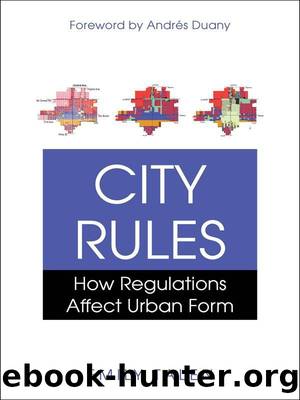City Rules by Emily Talen

Author:Emily Talen
Language: eng
Format: mobi
Publisher: Island Press
Published: 2012-06-22T00:00:00+00:00
Figure 4.23. Tampa zoning, 1966. The area had just two zoning districts.
There are other examples of how zoning’s increasing complexity undermined a healthy form of land-use mixing. The zoning changes of one small town in central Illinois, Urbana, home of the University of Illinois, illustrate the typical progression (City of Urbana 1990). The first zoning ordinance was passed in 1936. Up until 1950, there were no minimum lot widths and no lot areas required per unit. The 1950 ordinance contained only six zoning districts: two for residential, two for business, two for industrial. The 1979 ordinance changed this simplicity dramatically, introducing sixteen districts and two overlay zones. Though the setback requirements were reduced, apartments in single-family areas were no longer allowed, and minimum lot sizes and floor area ratio rules were introduced. Apartment buildings that had coexisted beautifully with single-family houses were made illegal. The main drivers of this downzoning were “neighborhood preservationists.” Planners had wisely urged that multifamily housing in single-family neighborhoods that were close to campus should be maintained because they would help with the redevelopment of obsolescent single-family housing, counter sprawl, meet a growing demand, and strengthen Urbana’s downtown. A decade later, under pressure from some long-time residents, planners labeled these assumptions “faulty” (City of Urbana 1990, 14).
Download
This site does not store any files on its server. We only index and link to content provided by other sites. Please contact the content providers to delete copyright contents if any and email us, we'll remove relevant links or contents immediately.
The Secret History by Donna Tartt(16627)
The Social Justice Warrior Handbook by Lisa De Pasquale(11489)
Thirteen Reasons Why by Jay Asher(7789)
This Is How You Lose Her by Junot Diaz(5775)
Weapons of Math Destruction by Cathy O'Neil(5038)
Zero to One by Peter Thiel(4824)
The Myth of the Strong Leader by Archie Brown(4789)
Promise Me, Dad by Joe Biden(4449)
Beartown by Fredrik Backman(4420)
Stone's Rules by Roger Stone(4417)
How Democracies Die by Steven Levitsky & Daniel Ziblatt(4399)
The Fire Next Time by James Baldwin(4343)
100 Deadly Skills by Clint Emerson(4079)
A Higher Loyalty: Truth, Lies, and Leadership by James Comey(4033)
Rise and Kill First by Ronen Bergman(4012)
The David Icke Guide to the Global Conspiracy (and how to end it) by David Icke(3883)
The Farm by Tom Rob Smith(3872)
Secrecy World by Jake Bernstein(3783)
The Doomsday Machine by Daniel Ellsberg(3732)
